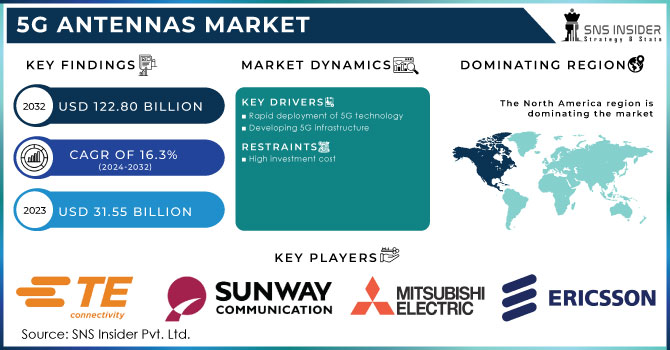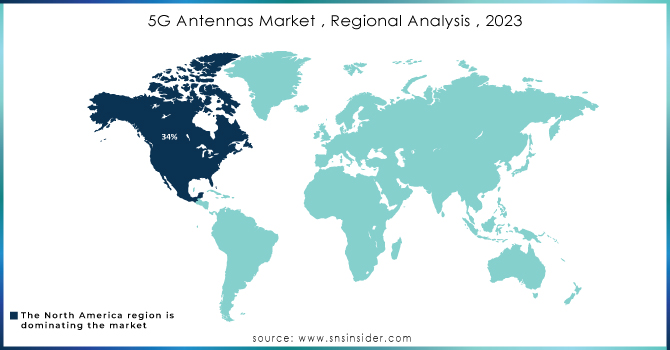5G Antennas Market Size:

Get more information on 5G Antennas Market - Request Sample Report
The 5G Antennas Market Size was valued at USD 13.60 Billion in 2023 and is expected to reach USD 38.41 Billion by 2032 and grow at a CAGR of 12.3% over the forecast period 2024-2032.
The 5G antennas market is expanding swiftly worldwide as more industries and regions adopt 5G technology. As a crucial component of 5G networks, antennas enable quicker data transmission, reduced latency, and improved connectivity for numerous applications, such as telecommunications, automotive, industrial automation, and smart cities. The growth of 5G infrastructure and the increasing need for sophisticated communication technologies have driven the creation and usage of cutting-edge antenna solutions.
The 5G antenna market is expanding quickly due to the swift deployment of 5G networks across the United States. As stated by the Federal Communications Commission, initiatives to enhance low-band spectrum use for 5G services have concentrated on the 600 MHz, 800 MHz, and 900 MHz bands, thereby increasing coverage and capacity.
Moreover, FCC actions in the 2.5 GHz, 3.5 GHz, and 3.7-4.2 GHz frequencies have released over 600 megahertz for 5G implementations, aiding in achieving equitable coverage and capacity traits vital for 5G development. These regulatory actions have boosted the need for sophisticated antenna technologies that can handle various frequency bands and provide uninterrupted connectivity. Furthermore, the DoD has recently released a strategy for deploying private 5G networks at military installations, aimed at leveraging 5G technology for enhanced mobile and data transfer abilities.
5G Antennas Market Dynamics
Key Drivers:
-
Increasing Deployment of 5G Networks Worldwide Drives the Demand for Advanced Antenna Technologies
The growth of 5G networks is significantly elevating the demand for advanced antenna technologies. Governments and telecom firms are heavily investing in the development of 5G infrastructure to meet the increasing need for fast, low-latency communication. These investments are also supported by favorable regulatory actions, such as spectrum auctions and incentives for infrastructure development. For instance, the Federal Communications Commission (FCC) in the U.S. has designated over 600 MHz of spectrum in various bands to accelerate the deployment of 5G. Innovations in antennas such as Massive MIMO and adaptive array antennas are crucial for meeting 5G performance benchmarks, enabling higher data speeds, improved coverage, and energy efficiency. This trend is particularly evident in developed countries and is gaining momentum in emerging markets, where initiatives for digital transformation are promoting widespread adoption of 5G services.
-
The proliferation of IoT Devices and Smart City Projects Augments the Need for High-Performance 5G Antennas
The rapid growth of IoT devices and smart city projects is creating considerable demand for efficient 5G antennas. Integrated systems and sensors are vital for smart cities to enhance urban administration, requiring robust 5G connectivity for seamless functioning. Similarly, IoT applications in healthcare, manufacturing, and retail are driving the adoption of 5G networks. These applications necessitate reliable, high-speed communication, which is enabled by advanced antenna technologies like beamforming and multi-beam antennas. Additionally, 5G antennas play a vital role in enabling connectivity for autonomous vehicles, industrial automation, and energy management systems. The growing reliance on 5G for crucial applications is expected to boost market growth in the coming years.
Restrain:
-
High Costs of 5G Infrastructure Deployment impede widespread Adoption, Affecting the Growth of the 5G antenna market
The deployment of 5G infrastructure is capital-intensive, posing a significant challenge to the widespread adoption of 5G antennas. High costs are associated with spectrum acquisition, infrastructure upgrades, and the integration of advanced technologies like Massive MIMO and beamforming. Telecom operators in developing regions often face financial constraints that delay 5G rollouts, impacting the demand for antennas. Additionally, the cost of integrating new antennas into existing network infrastructure adds to the overall expense, deterring smaller telecom providers and enterprises. While government initiatives and public-private partnerships aim to mitigate these costs, economic uncertainties and regulatory complexities further complicate deployment efforts. As a result, the high cost remains a critical restraint for the growth of the 5G antenna market, particularly in cost-sensitive regions.
5G Antennas Market Key Segments
By Type
The Switched Multi-Beam Antennas segment captured the largest revenue share of 58% in the 5G antennas market in 2023, driven by its ability to deliver improved signal coverage and efficient frequency utilization. These antennas are essential for handling high traffic volumes and optimizing network performance in dense urban areas. Leading companies like CommScope and Huawei Technologies have introduced advanced multi-beam antenna solutions to cater to the growing demand for 5G network coverage.
The Adaptive Array Antennas segment is projected to grow at the highest CAGR of 13.37% during the forecast period 2024-2032, fueled by advancements in beamforming and real-time signal adjustment capabilities. These antennas enhance network reliability and coverage, making them ideal for 5G applications such as autonomous vehicles, remote healthcare, and augmented reality. Companies like Ericsson and Nokia have been at the forefront of innovation in adaptive array antennas.
By Application
In 2023, the Automotive segment accounted for 62% of the revenue share in the 5G antennas market, driven by the rapid adoption of connected vehicle technologies and autonomous driving systems. Automotive manufacturers are increasingly incorporating 5G antennas to enable advanced features such as vehicle-to-everything (V2X) communication, real-time traffic updates, and remote diagnostics.
The infrastructure segment is projected to grow at the highest CAGR of 13.66% during the forecast period 2024-2032, driven by the rapid expansion of 5G base stations and smart city projects. 5G antennas are critical for infrastructure applications, enabling reliable communication for urban planning, energy management, and public safety systems. Leading companies such as Ericsson and Nokia Corporation have launched cutting-edge solutions to support infrastructure needs.
5G Antennas Market Regional Analysis
In 2023, North America dominated the 5G antennas market, accounting for an estimated market share of approximately 32%. This leadership position is driven by the region’s early adoption of 5G technology, robust investments in network infrastructure, and supportive government policies. The United States, in particular, has been a frontrunner, with major telecom operators like Verizon, AT&T, and T-Mobile aggressively rolling out 5G networks across urban and rural areas. The Federal Communications Commission (FCC) has played a crucial role by allocating spectrum and providing funding for rural 5G deployment under programs like the Rural Digital Opportunity Fund (RDOF).
The Asia Pacific region emerged as the fastest-growing market for 5G antennas in 2023, with an estimated CAGR of 14.08% during the forecast period. This rapid growth is fueled by significant investments in 5G infrastructure by major economies such as China, Japan, South Korea, and India. China leads the global 5G rollout, with telecom giants like Huawei Technologies and ZTE Corporation driving the development of advanced 5G antennas and base stations. For instance, Huawei's FDD Massive MIMO antennas have been widely adopted in China's 5G networks, enabling high-speed, reliable connectivity.

Need any customization research on 5G Antennas Market - Enquiry Now
Key Players
Some of the major players in the 5G Antenna Market are:
-
Ericsson (Active Antennas, Passive Antennas)
-
TE Connectivity (5G Antenna Solutions, 5G Antenna Modules)
-
Cobham Antenna Systems (5G Antenna Systems, 5G Antenna Solutions)
-
Shenzhen Sunway Communication (5G Antennas, 5G Antenna Modules)
-
Huizhou Speed Wireless Technology (5G Antennas, 5G Antenna Solutions)
-
Mitsubishi Electric Corporation (5G Antenna Systems, 5G Antenna Solutions)
-
Keysight Technologies (5G Antenna Test Systems, 5G Antenna Measurement Solutions)
-
National Instruments (5G Antenna Test Solutions, 5G Antenna Measurement Systems)
-
Huawei Technologies Co. Ltd (5G Antenna Systems, 5G Antenna Solutions)
-
Qualcomm Technologies, Inc. (5G Antenna Modules, 5G Antenna Solutions)
-
Samsung Electronics Co., Ltd. (5G Antenna Systems, 5G Antenna Solutions)
-
NEC Corporation (5G Antenna Systems, 5G Antenna Solutions)
-
Nokia Corporation (5G Antenna Systems, 5G Antenna Solutions)
-
Airgain Inc. (5G Antennas, 5G Antenna Modules)
-
Airspan Networks Inc. (5G Antenna Systems, 5G Antenna Solutions)
-
Comba Telecom Systems Holdings Limited (5G Antenna Systems, 5G Antenna Solutions)
Recent Trends
-
In February 2024, Ericsson revealed a new antenna for railway networks. The 5G-enabled antenna is going to revolutionize rail communications and promises to change the future of rail mobility through greater connectivity and higher speeds, ensuring enhanced communication for the entire railway system.
-
In May 2023, TE Connectivity launched its new Linx Cellular FPC antennas, which have been designed for 5G New Radio, LTE, and cellular IoT applications. It offers flexible printed circuit antennas that provide high-connectivity solutions for mobile devices and networks as the company continues to expand 5G technology.
-
In March 2024, Cobham Satcom teamed up with Inmarsat on SAILOR XTR GX-R2 antenna systems, which are optimized for next-generation connectivity for maritime operations, with future-proof tech. Reflecting the next generation of GX satellite technology, these antennas represent a new benchmark in maritime satcom connectivity.
| Report Attributes | Details |
|---|---|
| Market Size in 2023 | USD 13.60 Billion |
| Market Size by 2032 | USD 38.41 Billion |
| CAGR | CAGR of 12.3 % From 2024 to 2032 |
| Base Year | 2023 |
| Forecast Period | 2024-2032 |
| Historical Data | 2020-2022 |
| Report Scope & Coverage | Market Size, Segments Analysis, Competitive Landscape, Regional Analysis, DROC & SWOT Analysis, Forecast Outlook |
| Key Segments | • By Antenna Type (Switched Multi-beam Antennas, Adaptive Array Antennas) • By Technology Type (SIMO, MISO, MIMO) • By Application Type (Automotive, Infrastructure, Other) |
| Regional Analysis/Coverage | North America (US, Canada, Mexico), Europe (Eastern Europe [Poland, Romania, Hungary, Turkey, Rest of Eastern Europe] Western Europe] Germany, France, UK, Italy, Spain, Netherlands, Switzerland, Austria, Rest of Western Europe]), Asia Pacific (China, India, Japan, South Korea, Vietnam, Singapore, Australia, Rest of Asia Pacific), Middle East & Africa (Middle East [UAE, Egypt, Saudi Arabia, Qatar, Rest of Middle East], Africa [Nigeria, South Africa, Rest of Africa], Latin America (Brazil, Argentina, Colombia, Rest of Latin America) |
| Company Profiles | Ericsson, TE Connectivity, Cobham Antenna Systems, Shenzhen Sunway Communication, Huizhou Speed Wireless Technology, Mitsubishi Electric Corporation, Keysight Technologies, National Instruments, Huawei Technologies Co. Ltd, Qualcomm Technologies, Inc., Samsung Electronics Co., Ltd., NEC Corporation, Nokia Corporation, Airgain Inc., Airspan Networks Inc., Comba Telecom Systems Holdings Limited, CommScope Holding Company Inc. |
| Key Drivers | • Increasing Deployment of 5G Networks Worldwide Drives the Demand for Advanced Antenna Technologies. • The proliferation of IoT Devices and Smart City Projects Augments the Need for High-Performance 5G Antennas. |
| Restraints | • High Costs of 5G Infrastructure Deployment impede widespread Adoption, Affecting the Growth of the 5G antenna market. |

